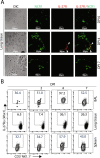IL-27 promotes NK cell effector functions via Maf-Nrf2 pathway during influenza infection
- PMID: 30899058
- PMCID: PMC6428861
- DOI: 10.1038/s41598-019-41478-6
IL-27 promotes NK cell effector functions via Maf-Nrf2 pathway during influenza infection
Abstract
Influenza virus targets epithelial cells in the upper respiratory tract. Natural Killer (NK) cell-mediated early innate defense responses to influenza infection include the killing of infected epithelial cells and generation of anti-viral cytokines including interferon gamma (IFN-γ). To date, it is unclear how the underlying cytokine milieu during infection regulates NK cell effector functions. Our data show during influenza infection myeloid cell-derived IL-27 regulates the early-phase effector functions of NK cells in the bronchioalveolar and lung tissue. Lack of IL-27R (Il27ra-/-) or IL-27 (Ebi3-/-) resulted in impaired NK cell effector functions including the generation of anti-viral IFN-γ responses. We identify CD27+CD11b+ NK cells as the primary subset that expresses IL-27R, which predominantly produces IFN-γ within the upper respiratory tract of the infected mice. IL-27 alone was incapable of altering the effector functions of NK cells. However, IL-27 sensitizes NK cells to augment both in vitro and in vivo responses mediated via the NKG2D receptor. This 'priming' function of IL-27 is mediated partly via transcriptional pathways regulated by Mafs and Nrf2 transcriptionally regulating TFAM and CPT1. Our data for the first time establishes a novel role for IL-27 in regulating early-phase effector functions of NK cells during influenza infection.
Conflict of interest statement
The authors declare no competing interests.
Figures








Similar articles
-
Interleukin-22 (IL-22) production by pulmonary Natural Killer cells and the potential role of IL-22 during primary influenza virus infection.J Virol. 2010 Aug;84(15):7750-9. doi: 10.1128/JVI.00187-10. Epub 2010 May 26. J Virol. 2010. PMID: 20504940 Free PMC article.
-
Engagement of TLR3, TLR7, and NKG2D regulate IFN-gamma secretion but not NKG2D-mediated cytotoxicity by human NK cells stimulated with suboptimal doses of IL-12.J Immunol. 2007 Sep 15;179(6):3472-9. doi: 10.4049/jimmunol.179.6.3472. J Immunol. 2007. PMID: 17804388
-
Requirement for natural killer cell-produced interferon gamma in defense against murine cytomegalovirus infection and enhancement of this defense pathway by interleukin 12 administration.J Exp Med. 1995 Oct 1;182(4):1045-56. doi: 10.1084/jem.182.4.1045. J Exp Med. 1995. PMID: 7561678 Free PMC article.
-
Implications of a 'Third Signal' in NK Cells.Cells. 2021 Jul 31;10(8):1955. doi: 10.3390/cells10081955. Cells. 2021. PMID: 34440725 Free PMC article. Review.
-
Interferon-gamma: biologic functions and HCV therapy (type I/II) (1 of 2 parts).Clin Ter. 2006 Jul-Aug;157(4):377-86. Clin Ter. 2006. Retraction in: Clin Ter. 2008 May-Jun;159(3):207. PMID: 17051976 Retracted. Review.
Cited by
-
Antiviral Activities of Interleukin-27: A Partner for Interferons?Front Immunol. 2022 May 10;13:902853. doi: 10.3389/fimmu.2022.902853. eCollection 2022. Front Immunol. 2022. PMID: 35634328 Free PMC article. Review.
-
IL-27 Rα+ cells promoted allorejection via enhancing STAT1/3/5 phosphorylation.J Cell Mol Med. 2020 Sep;24(18):10756-10767. doi: 10.1111/jcmm.15700. Epub 2020 Aug 6. J Cell Mol Med. 2020. PMID: 32761753 Free PMC article.
-
Potential Molecular Mechanisms and Remdesivir Treatment for Acute Respiratory Syndrome Corona Virus 2 Infection/COVID 19 Through RNA Sequencing and Bioinformatics Analysis.Bioinform Biol Insights. 2021 Dec 23;15:11779322211067365. doi: 10.1177/11779322211067365. eCollection 2021. Bioinform Biol Insights. 2021. PMID: 34992355 Free PMC article.
-
Interleukin 27, like interferons, activates JAK-STAT signaling and promotes pro-inflammatory and antiviral states that interfere with dengue and chikungunya viruses replication in human macrophages.Front Immunol. 2024 Apr 24;15:1385473. doi: 10.3389/fimmu.2024.1385473. eCollection 2024. Front Immunol. 2024. PMID: 38720890 Free PMC article.
-
IL27 Signaling Serves as an Immunologic Checkpoint for Innate Cytotoxic Cells to Promote Hepatocellular Carcinoma.Cancer Discov. 2022 Aug 5;12(8):1960-1983. doi: 10.1158/2159-8290.CD-20-1628. Cancer Discov. 2022. PMID: 35723626 Free PMC article.
References
-
- Santoli D, Trinchieri G, Koprowski H. Cell-mediated cytotoxicity against virus-infected target cells in humans. II. Interferon induction and activation of natural killer cells. J Immunol. 1978;121:532–538. - PubMed
Publication types
MeSH terms
Substances
Grants and funding
LinkOut - more resources
Full Text Sources
Other Literature Sources
Molecular Biology Databases
Research Materials

